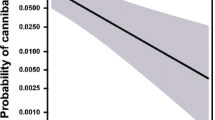Abstract
The relationship between the quality/quantity of male investment and the feeding behavior of females was investigated in a bruchid weevil, Bruchidius dorsalis (Fahraeus), whose males donate nutrition via seminal fluid to females. Experiments on the effect of feeding regimes of both sexes on the mating frequency of females showed that females mated at a higher frequency if given low-quality food or poor male investment. On the other hand, the experiment that examined the effect of male investment quality on female feeding behavior showed that females receiving the high-quality investment exhibited feeding behavior less often. These results suggest that male investment and feeding behavior play the same role for B. dorsalis females. These experiments also showed that there are sex-related asymmetries in mating and feeding behaviors: females mated more often but males fed more often. Moreover, a field census suggested that only males visited non-host flowers to feed on the pollen and nectar during the non-flowering period of the host plants; females always stayed on the host plants irrespective of the flowering phenology. These results suggest that in B. dorsalis courtship role reversal and sex-specific feeding modes are fairly fixed and obligatory, and that male investment, derived from sexual selection, could affect the feeding behavior and spatial distribution of both sexes, which may have far-reaching impact in various ecological contexts.


Similar content being viewed by others
References
Andersson M (1994) Sexual selection. Princeton University Press, Princeton, N.J.
Boucher L, Huignard J (1987) Transfer of male secretions from the spermatophore to the female insect in Caryedon serratus (OL.): analysis of the possible trophic role of these secretions. J Insect Physiol 33:949–957
Bowen BJ, Codd CG, Gwynne DT (1984) The katydid spermatophore (Orthoptera: Tettigoniidae): male nutritional investment and its fate in the mated female. Aust J Zool 32:23–31
Brown GP, Weatherhead PJ (1999) Female distribution affects mate searching and sexual selection in male northern water snakes (Nerodia sipedon). Behav Ecol Sociobiol 47:9–16
Emlen ST, Oring LAW (1977) Ecology, sexual selection, and the evolution of mating systems. Science 197:215–223
Friedel T, Gillott C (1977) Contribution of male produced proteins to vitellogenesis in Melanoplus sanguinipes. J Insect Physiol 23:145–151
Gwynne DT (1993) Food quality controls sexual selection in Mormon crickets by altering male mating investment. Ecology 74:1406–1413
Gwynne DT, Simmons LW (1990) Experimental reversal of courtship roles in an insect. Nature 346:172–174
Gwynne DT, Bowen BJ, Codd CG (1984) The function of the katydid spermatophore and its role in fecundity and insemination (Orthoptera: Tettigoniidae). Aust J Zool 32:15–22
Gwynne DT, Winston JB, Annells A (1998) The sex in short supply for matings varies over small spatial scales in a katydid (Kawanaphila nartee, Orthoptera: Tettigoniidae). Behav Ecol Sociobiol 42:157–162
Huignard J (1983) Transfer and fate of male secretions deposited in the spermatophore of females of Acanthocelides obtecus Say. J Insect Physiol 29:55–63
Johnson JC, Ivy TM, Sakaluk SK (1999) Female remating propensity contingent on sexual cannibalism in sagebrush crickets, Cyphoderris strepitans: a mechanism of cryptic female choice. Behav Ecol 10:227–233
Nojima S, Sakuma M, Nishida R, Kuwahara Y (1999) A glandular gift in the German cockroach, Blattella germanica (L.) (Dictyoptera: Blattellidae): the courtship feeding of a female on secretions from male tergal glands. J Insect Behav 12:627–640
Shinoda K, Yoshida T (1990) Life history of azuki bean weevil, Callosobruchus chinensis L., (Coleoptera: Bruchidae), in the field. In: Fujii K, Gatehouse AMR, Johnson CD, Mitchel R, Yoshida T (eds) Bruchids and legumes: economics, ecology and coevolution. Kluwer Academic, Dordrecht, pp 149–159
Shinoda K, Yoshida T (1991) Effect of fungal feeding on longevity and fecundity of the azuki bean weevil, Callosobruchus chinensis (L.), in the azuki bean field. Appl Entomol Zool 22:456–473
Simmons LW, Bailey WJ (1990) Resource influences sex roles of zaprochiline tettigoniids (Orthoptera: Tettidoniidae). Evolution 44:1853–1868
Simmons LW, Gwynne DT (1993) Reproductive investment in bushcrickets: the allocation of male and female nutrients to offspring. Proc R Soc Lond B 252:1–5
Smith RL (1979) Paternity assurance and altered roles in the mating behavior of a giant water bug, Abedus herberti (Heteroptera: Belastomatidae). Anim Behav 27:716–725
Takakura K (1999) Active female courtship behavior and male nutritional contribution to female fecundity in Bruchidius dorsalis (Fahraeus) (Coleoptera: Bruchidae). Res Popul Ecol 41:269–273
Takakura K (2001) Courtship-role-reversal in the bean weevil, Bruchidius dorsalis (Coleoptera: Bruchidae): interplay between male-male competition and cryptic female choice. Appl Entomol Zool 36:311–316
Thornhill R (1976) Sexual selection and nuptial feeding behavior in Battacus apicalis (Insecta: Mecoptera). Am Nat 110:529–548
Thornhill R (1979) Adaptive female-mimicking behavior in a scorpionfly. Science 205:412–414
Van der Reijden ED, Monchamp JD, Lewis SM (1997) The formation, transfer, and fate of spermatophores in Photinus fireflies (Coleoptera: Lampyridae). Can J Zool 75:1202–1207
Watanabe N (1990) Diversity in life cycle patterns of bruchids occurring in Japan (Coleoptera: Bruchidae). In: Fujii K, Gatehouse AMR, Johnson CD, Mitchel R, Yoshida T (eds) Bruchids and legumes: economics, ecology and coevolution. Kluwer Academic, Dordrecht, pp 141–147
Yasui Y (1998) The 'genetic benefits' of female multiple mating reconsidered. Trend Ecol Evol 6:246–250
Acknowledgements
I thank Dr. T. Nishida of Kyoto University for critical reading of this manuscript and valuable comments. I also thank Dr. E. Kuno for his suggestion and encouragement of this study.
Author information
Authors and Affiliations
About this article
Cite this article
Takakura, Ki. The nutritional contribution of males affects the feeding behavior and spatial distribution of females in a bruchid beetle, Bruchidius dorsalis . J Ethol 22, 37–42 (2004). https://doi.org/10.1007/s10164-003-0093-z
Received:
Accepted:
Published:
Issue Date:
DOI: https://doi.org/10.1007/s10164-003-0093-z




